Optimizing Your Video Content for YouTube Search
Doug Miller#Digital Marketing, #SEO, #Video Marketing Strategy

YouTube is the world's 2nd largest search engine, so it's important to optimize YouTube content for search. We offer some valuable tips on how to do so.
YouTube as a Search Engine
As we covered last time, the three primary aspects of YouTube to consider are its role as: a video streaming platform, a social network, and ostensibly the 2nd largest search engine.
This time we are going to focus on the third (and perhaps most important) aspect of YouTube as a search engine and discuss three of the things to remember for optimizing your video content to perform well in YouTube search. There are many factors to consider, but among the most important are:
- Keywords are still vital, but what does your video demonstrate?
- What are you using for titles and descriptions?
- I found your video; now what?
In many ways, the success Google has had (through YouTube) with the first two factors has led to the third. For that reason, many organizations will find it beneficial to maintain a presence in this space, despite some compelling reasons to turn to other tools for many video content marketing campaigns. We’ll cover some of those tools in future posts, and I've spent a fair amount of time writing about some of them already, but this post will focus on optimizing your video for YouTube powered search, so we'll assume that being present on the platform is a foregone conclusion.
Keywords
When I sat down with a few organizations for my 15 minute power sessions on video content marketing strategy, the first thing I did was ask them if they have any content on YouTube. Everyone said yes, but most said they could be approaching it more strategically.
The second thing I would do when I sat down with them was to begin typing their organization’s name into a YouTube search. This was an interesting process, because there was some real suspense that was created around the question of what "autocomplete" suggestions would appear as more letters were typed into the search bar.
Below you will see an example of YouTube auto-complete. Notice the phrases as trending queries. The word "how" is on the rise in search.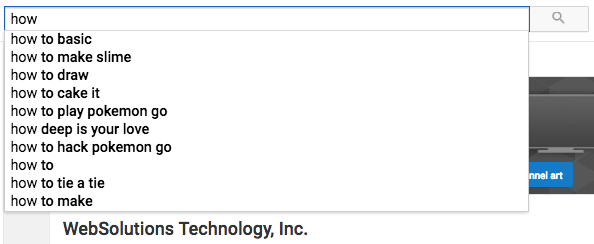
Some people were pleasantly surprised by the words associated with their autocomplete results, and some not so much, from a PR point of view. In any case, beginning here gave them a good sense of what folks were already searching for around their brand identity. As we know, however, the best individuals to appear in front of in search results are often people who don’t know they are looking for you (and are not searching for any of your brand names). Identifying and optimizing your YouTube content to show up in that manner in a YouTube search is key, and it begins with your keyword research.
In many ways, YouTube search results are not all that different from search results that are powered by any other search engine. In fact, YouTube results themselves often command a prime piece of real estate in standard Google search engine results pages (SERPs). In that way, optimizing your video content is not all that dissimilar from optimizing any web page, and many of the same keyword research tools an organization might turn to (MOZ, SEMrush, etc.) will serve some value. As we have seen in the past, however, the rules for how web pages rank in search results can be far from simple and are subject to change, and searching for videos on YouTube is ultimately a different process. This means that it is important to know how and why before doing research for YouTube keyword ranking.
The Importance of Text
Even though the results of a YouTube search might look a little different from a standard web page search engine, the machines themselves (the algorithms that index, categorize, and rank all possible results) still use the same key indicators for that process. There may come a time when the machines used to index and display our video search results are smart enough to do so based on the audio-visual information contained INSIDE a video itself. Indeed, YouTube uses similar software to scan your video content for potential copyright violations. For now, however, good old fashioned text is what YouTube uses to index, categorize, and rank your videos, and that all happens OUTSIDE your video.
Below you will see a standard YouTube search results page example (with added insight from VidIQ):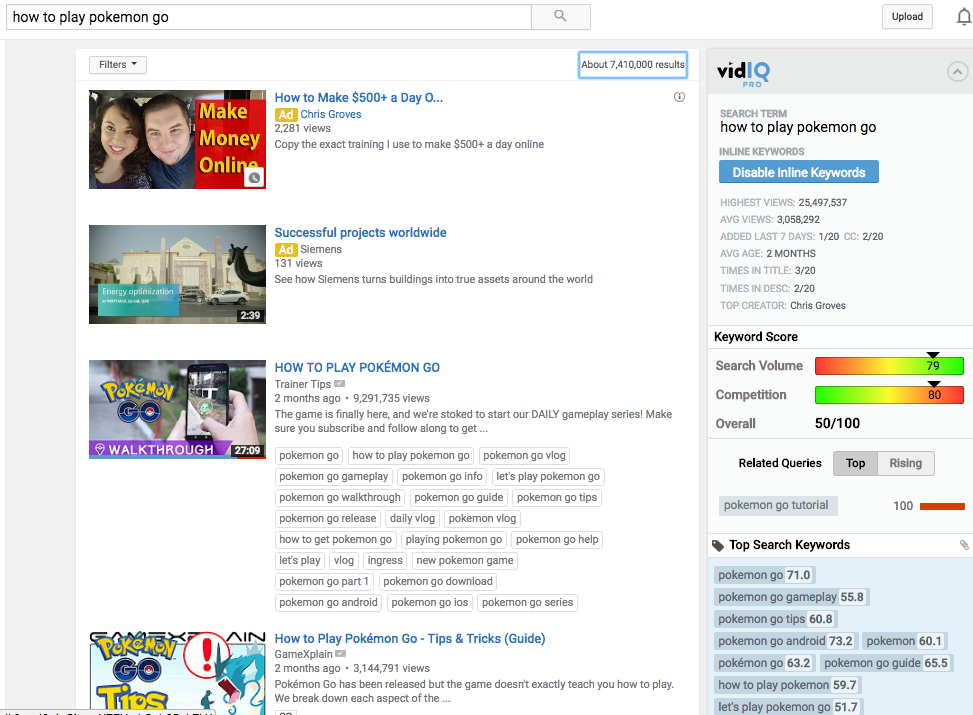
In order to be considered for display in YouTube powered search results, it’s key that, when you place your videos inside YouTube, you must make sure to put the right words in the right places. Getting the right keywords can be a very involved process. As mentioned, an organization seeking to optimize their video marketing content for YouTube search might start with the keywords they would have assigned to a given campaign for a web page, but those keywords may not have anything to do with the way users are searching on YouTube.
Asking the Right Questions
As mentioned in the last post, YouTube has seen a dramatic increase in the search volume for keyword phrases like “how to,” so understanding your YouTube content from a “how to” point of view will help you uncover relevant keywords to target. One way that you can go about thinking of your content in that manner is to ask a few questions: What does this video demonstrate? What does it show?
A video for a school, for example, that is based around freshman orientation might lead that organization to use “freshman orientation” as one keyword phrase, and that is valid. However, when you start thinking about the content from a “how to” point of view, ensuring that keywords mention that the video demonstrates “how to move in for your freshman year at x school” might prove more effective in a YouTube search context.
Below you will see an example of a video page on YouTube with added insights from VidIQ about tags and ranking (in this case for Pokemon Go):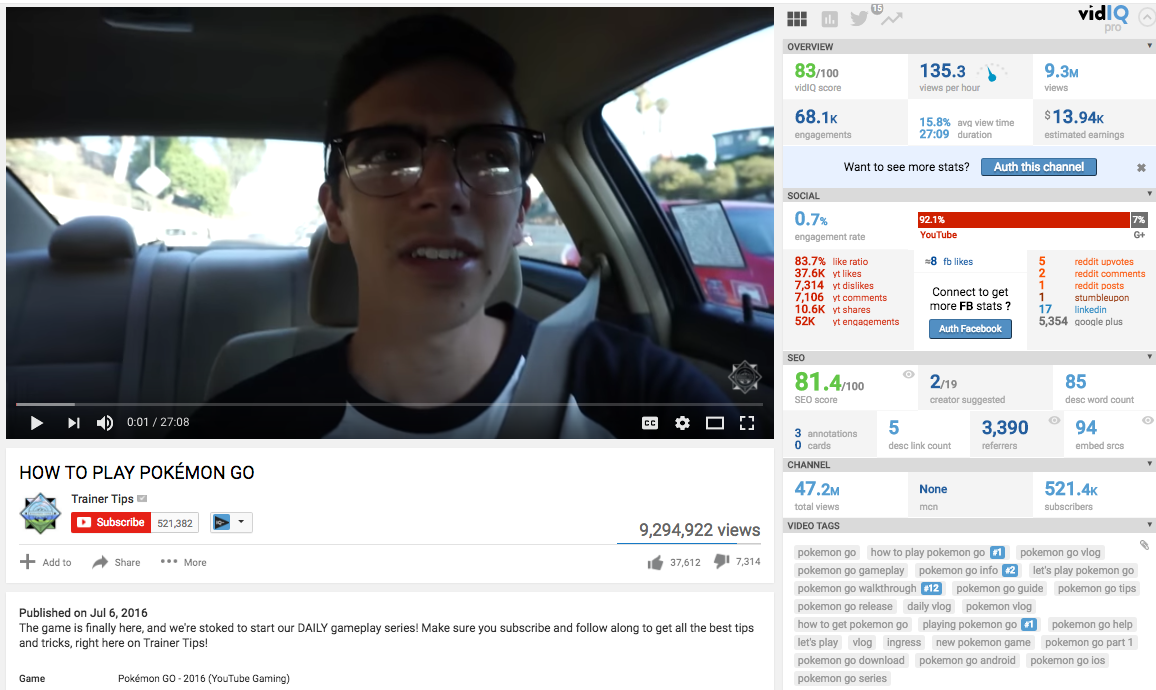
At this point in the 15 minute power sessions I had at EduWeb, we would pull up a few of their existing videos to find out whether or not those videos made use of the tagging that YouTube makes available. Using a special software tool, we were then able to see if the organization was actually ranking for any of those terms in YouTube search, and if so, at what position on results pages. This also gave us a sense of the search volume that these keywords were likely to have in general.
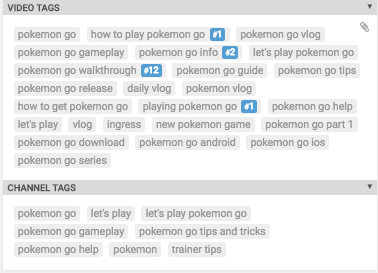
Internal vs. External Keywords
I think a real “aha” moment came for people who were already making use of the tags that YouTube makes available. While the terms that they were using were logical, in that they might have been useful for identifying what the video content was about from an INTERNAL point of view, they were often not very useful for identifying what the video was about from an EXTERNAL point of view.
Many organizations were using jargon and terminology to identify these videos, but the truth is, even though these terms may make sense to internal audiences, the search volume for those tags simply wasn’t there. At this point, we would start a conversation about ways that EXTERNAL audiences might search for videos that DEMONSTRATE what they want to have shown to them. Once we came up with a few ideas, we used another software tool to get a sense of search volume for those words. Being able to identify and target the terms that people are actually searching for makes a big difference toward making sure an organization's content can be found in YouTube searches.
Titles and Descriptions
The same rules mentioned above are true for the way that keywords are used in the title and description fields of YouTube videos. YouTube search relies on titles and descriptions as ranking factors for keywords, but I am always surprised to see how little attention both of these fields get. I often see video titles that are simply the filename of the video that was uploaded, with no description at all. There could not be a worse configuration for appearing in YouTube search.
Below you will see an example of a YouTube title area for this Pokemon Go related video that has 5/5 keywords in the title area, but only 2/5 in the description area:

Likewise, many organizations used the same INTERNAL keywords mentioned above, if they bothered to include a detailed title and description at all. While it's tempting to use this type of jargon to categorize videos, they don't do a very good job of talking about what the video actually SHOWS.
Next Steps
Finally, as I sat with organizations and talked about some potential research options for keywords that might help them appear more strategically in YouTube search (including exported data about what keywords their competition was using), I would ask them about what action, if any, they would want someone who just watched their video to take. I found that most of the time, their thinking ended with the watching of the video.
When it comes to optimizing your video content for YouTube search, a key factor YouTube uses for ranking videos has to due with the amount of time users spend with the content, both on the individual video and the channel. The more views you have as a channel, and the more time each spent watching the video (duration of view compared to total running time), the more likely it is that YouTube will consider your content for both display in search results and in the increasingly important autoplay or suggested related videos areas. We’ll talk more about autoplay and those suggested videos next time, but suffice to say that even if you don’t have a direct call to action (CTA) for your video (RSVP for this event, read this blog post, etc.), you should encourage people to explore more of your videos and subscribe for updates about new videos that are released.
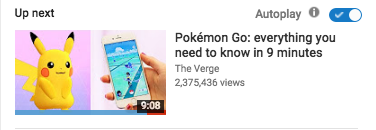
When it comes to video, there are many more things to talk about, including ways to make sure that someone who sees your video in a search result is compelled to watch your video. As with my 15 minute power sessions while at EduWeb16, there is no way I can cover everything in our brief interactions here, but I’d love to talk to you if you’d like to know more about how Diagram can help you solve some of these video-specific content marketing problems! If you have any questions or tips of your own, please share them in the comments below.
Related Posts
The Continuing Rise of Zero-Click Search (and What You Can Do About It)
In a zero-click internet search environment, your website needs to be fully-optimized for every organic click - here's what you need to do..

Generative Engine Optimization (GEO): Creating Content For AI-Search
Generative Engine Optimization (GEO) boosts your content's visibility in AI search. Discover 5 key strategies for platforms like Perplexity and Gemini.
Results Matter.
We design creative digital solutions that grow your business, strengthen your brand and engage your audience. Our team blends creativity with insights, analytics and technology to deliver beauty, function, accessibility and most of all, ROI. Do you have a project you want to discuss?
Like what you read?
Subscribe to our blog "Diagram Views" for the latest trends in web design, inbound marketing and mobile strategy.
